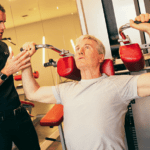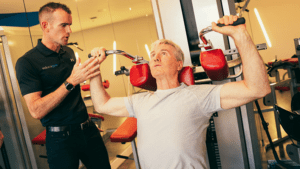It is results you want, right?
How we age:
Let me remind you about a few depressing but inevitable facts about ageing. Firstly as we age we lose about 30% of our muscle mass[1]. Actually after the age of 30 we lose muscle at the rate of about a half a pound per year[2] [3]. Unfortunately, this also includes muscle mass from our vital organs[4].
Even if we stay the same body weight throughout our lifetime, fat replaces muscle tissue[2]. This can lead to cardiovascular problems (your heart is 90% muscle), poorly functioning organs, such as your liver, brain, heart and reduced hormone secretion. As a result our bodies go from shapely to shapeless as we lose our strength, feel, look and become old.
How we get fat:
Secondly muscle loss not only causes all of these problems but also results in a lowered metabolism (the rate at which you burn food and body fat for energy). Research shows that a pound of muscle burns approximately 50 to 100 calories per day[2].
Unfortunately for every pound of muscle that you lose it becomes easier to gain fat even when your food intake remains the same. On average over our lifetime, muscle loss slows down your metabolism by as much as 45%[4]. Ultimately, you have unsightly, soft fat where you once had youthful, toned muscle.
Aerobics can make you fat!
Here is where it gets interesting. When people find themselves becoming overweight, they generally start doing aerobics. Research shows that an hour of aerobics, if the calorie intake stays constant, causes weight loss. Sadly however, most of this weight loss is vital muscle[5]. Since body fat is burned almost exclusively by your muscle tissue, it is the one thing you cannot afford to lose[3].
Low calorie diets can make you fat!
Studies also now show that low calorie diets cause weight loss but once again much of this is muscle tissue2. Research shows that crash weight-loss plans cause people to lose up to 90% of their weight from muscle – including from their vital organs[3].
Such plans include diets with too few calories and macronutrients (protein, fat, carbohydrate), causing the body to use its own muscle for fuel[3]. When you lose muscle tissue in this way, your body composition becomes similar to that of an old person.
Are you working hard to get older?
Science shows us that any form of exercising or dieting that causes us to lose muscle is a serious step in the wrong direction. In fact, you are actually breaking down the firm body you hoped to produce.
Indeed, to lose muscle is extremely damaging to your health, including your immune system and greatly accelerates the rate at which you age[2]. Due to misinformation you have speeded up the ageing process, in spite of all your sacrifice, willpower and hard work.
Muscle Burns Fat:
An hour of aerobics, depending on how vigorous, would burn approximately 400 to 500 calories per day. Endlessly you see the ads on TV promising the latest and greatest workout equipment. What makes it the greatest? Why, the fact that it burns more calories than its competitors of course.
But anyone who focuses exclusively on the number of calories burned while exercising is missing the bigger picture, i.e. the amount of calories you burn while resting! 10 pounds of muscle burns between 500 to 1000 calories per day – even during sleep or while watching TV[2]. Of the total amount of calories your body burns, 90% are burned by muscle. Think of muscle as a furnace in which you burn calories.
Best defence against ageing:
The solution to all of the above is to regain, grow or maintain your muscle mass. If up till now you have lost muscle, then if you want true rejuvenation you must gain back the loss. Even if you are young and beginning to become over-fat, you need to increase your muscle to correct this problem.
If you are already in good shape the most anti-ageing step you can take is to continue to hold onto your invaluable muscle. In short, your muscles are your best defence against ageing and body fat.
The Ground-Breaking University Study:
Clearly any approach used should have as its primary goal the increase of muscle tissue. So what is the best form of exercise, diet or even food supplements for this purpose?
A University Doctoral study examined these questions and came to a ground-breaking conclusion:
The most important factor was the trainees’ mental attitude. Other important factors were weight training, no resting between exercises, low glycemic foods and some food supplements. The research highlighted the fact that the more focused the trainees’ mental attitude, the heavier the weight they could lift. In turn, this greater intensity of effort was directly related to increases in muscle tissue.
The results over a 12 day period and a total of 4 hours of weight training – i.e. 20 minutes daily – were on average a gain of 3 lbs. of muscle and a loss of 7.5 lbs. of fat. Look at the picture on the front page to see what this looks like.
This almost one pound a day change would be enough to literally transform the average person’s body.
Awesome Gyms?
The gyms today can only be described in one word – awesome. Step inside one and you will see masses of shiny, very expensive equipment and row after row of aerobic machines. Now, all of this is there for just one reason – to give people equally awesome results.
Are you a member of one of these awesome gyms? Are you getting the type of results you see here? Do you know anybody that is?
Indeed, the results you have read about here would be impossible in these gyms because, according to re- search, in a 20 minute workout it was found that 10 minutes were lost moving from and setting up the equipment[6]. Naturally this considerably reduces the intensity during the workout time and consequently the results.
Then there is the question of supervision. Even if the trainers are excellent, because of the very size of the gym it becomes difficult to adequately supervise people. Of course, you can always hire a personal trainer. Before you do so you should enquire as to the results they are obtaining with their average client. After all, you expect results for your now rather more expensive investment.
The Time Machine:
To allow people to benefit from the university research it was necessary to develop a new form of exercise machine that literally outdates anything that has gone before. This machine allows any part of the body to be worked at maximum intensity, in a virtually continuous manner for the duration of the workout.
It was given the name The Time Machine for two reasons. Firstly because it allowed all of the workout time to be used for maximum results and secondly because of the almost a pound a day of positive change in a person’s body who passed through the machine and seemed to become their younger selves.
The machine fits into a space of around 250 square feet. This allows the client to receive the necessary level of supervision to obtain the results and at approximately half the price of a personal trainer.
Educo®
The word Educo® comes from Latin and means ‘to draw out from within’. The aim of the educogym® is to draw out your more youthful figure / physique from within. In the university study it was found that in order to generate peak physical intensity it was necessary to fully concentrate the mind on the movement. Therefore the person was actually drawing out more of their mental potential to achieve the results.
They were literally training both their bodies and minds. The resultant in- crease in mind power and concentration was shown to benefit many other areas of people’s lives.
Consequently, an essential part of the educogym® training programme is to teach people to fully apply their mind for maximum results. In addition it also includes the essential information on nutrition and food supplements.
Let Results Decide:
Today, more than ever before we are bombarded from every side about getting into shape, exercise, weight loss, fitness, anti-ageing and the latest and greatest diet, food supplement, protein shake, health drink, etc. So how are you to know what to do? The answer is simple – forget the hype, just decide based on the results.
References:
[1] Faulkner JA., Brooks SV., Zerba E. Muscle atrophy and weakness with ageing: Contraction induced injury as an underlying mechanism. Journal of Gerentology a Biological Science Medical Science. 1995; 50:124.
Lexell.J. Human aging, muscle mass and fiber type composition. Journal of Gerentology a Biological Science Medical Science. 1995: 50:11.
Rogers MA. Evans WJ. Changes in skeletal muscle with ageing effects of exercise training. Exercise Sports Science Review 1993: 21:65.
[2] Schuler L (2003) The testosterone advantage plan: New York: Fireside.
[3] Accu-Measure Inc. (1991). The purpose of the accu-track system. In The personal fat management guide. USA: Accu-Measure Inc.
[4] Blazejowski CA. Webster GC, Decreased rates of protein synthesis by cell free preparations from different organs of ageing mice. Mech Ageing Development. 1983; 21:245.
Parrado J et al. Effects of ageing on the various steps of protein synthesis: Fragmentation of elongation factor 2. Free radical Biological Medicine. 1999: 26:362.
Rattan SL, Derventzi A, Clark BF. Protein synthesis, posttranslational modification and ageing. Annals of the New York Academy of Science 1992; 663:48.
[5] Lindholm C, et al. Altered adrenal steroid metabolism underlying hypercortisolism in female endurance athletes. Fertl Steril. 1995; 63: 1190.
Maron MB, Horvath SM, Wilkerson JE. Acute blood biochemical alterations in response to marathon running. European Journal of Physiology. 1975; 34:173.
Morville R, et al. Plasma variations in testicular and adrenal androgens during prolonged physical exercise in man. Annals of Endocrinology. 1979; 40:501.
Newmark ST, et al. Adrenocortical response to marathon running . Journal of Clinical Endocrinology Metabolism. 1976; 42: 393.
Tegelman R, et al. Endogenous anabolic and catabolic steroid hormones in male and female athletes during the off season. International Journal of Sports Medicine. 1990; 11: 103.
Cook NJ, et al. Salivary cortisol for monitoring adrenal activity during marathon runs. Hormonal Research 1987; 25:18.
Dohm GL, Tapscott EB, Kasperek GJ. Protein degradation during endurance exercise and recovery. Medical Science Sports Exercise. 1987; 19 (Suppl): S166.
[6] Tsai L, et al 1991









